Every once in a while, I come across a book to which I return over and over again, a book that informs my work as an architect. For a change of pace, this time I pay homage to some of the books that have helped molded me, and whose words never grow old to me.
For my first such venture I present Architecture: Form, Space and Order. Never mind that author Frank Ching has a whole section of Amazon.com dedicated to his work. Never mind that this book was required reading my freshman year at Georgia Tech. Never mind that my dog ate my twenty-five year old copy and I bought a new, updated version last year. This book, in very direct words and imagery, lays out some of the most basic principles of the art of Architecture.
Whenever I question on of my design decisions, this book helps focus my decision-making process. It breaks down the question of design into its most fundamental principles. Ching analyzes forms, their relationships, and their organization, as well as how circulation between, through and around these forms activates them. With an astounding simplicity and elegance, Ching lays out the craft of architecture for all to understand.
This isn't to say that architecture can necessarily be broken down into a series of quantifiable rules and properties. The most cursory viewing of such enlightened spaces as Le Corbusier's Notre Dame du Haut in Ronchamps, Tadao Ando's Church of Light, and Freed's Holocaust Museum readily shows that the most moving of architectures incorporate not only discernable design principles, but also an element of inspiration that proves the rules by manipulating, even breaking, them, adding an unmistakable touch of inspiration.
Ching, however, masterfully reduces architectural principles into their most basic and most distilled essences. The artwork in the book, beautiful linework with superimposed graphics that illustrate each principle, helps pin down each of the themes of the book. Form, space, circulation, order, proportion, scale and basic principles, each theme serves as the basis of the beginnings of a language that every architect should learn. And the earlier the better.
For my first such venture I present Architecture: Form, Space and Order. Never mind that author Frank Ching has a whole section of Amazon.com dedicated to his work. Never mind that this book was required reading my freshman year at Georgia Tech. Never mind that my dog ate my twenty-five year old copy and I bought a new, updated version last year. This book, in very direct words and imagery, lays out some of the most basic principles of the art of Architecture.
Whenever I question on of my design decisions, this book helps focus my decision-making process. It breaks down the question of design into its most fundamental principles. Ching analyzes forms, their relationships, and their organization, as well as how circulation between, through and around these forms activates them. With an astounding simplicity and elegance, Ching lays out the craft of architecture for all to understand.
This isn't to say that architecture can necessarily be broken down into a series of quantifiable rules and properties. The most cursory viewing of such enlightened spaces as Le Corbusier's Notre Dame du Haut in Ronchamps, Tadao Ando's Church of Light, and Freed's Holocaust Museum readily shows that the most moving of architectures incorporate not only discernable design principles, but also an element of inspiration that proves the rules by manipulating, even breaking, them, adding an unmistakable touch of inspiration.
Ching, however, masterfully reduces architectural principles into their most basic and most distilled essences. The artwork in the book, beautiful linework with superimposed graphics that illustrate each principle, helps pin down each of the themes of the book. Form, space, circulation, order, proportion, scale and basic principles, each theme serves as the basis of the beginnings of a language that every architect should learn. And the earlier the better.





